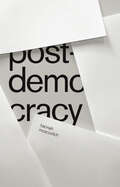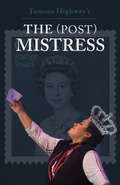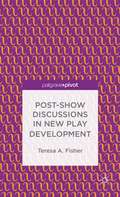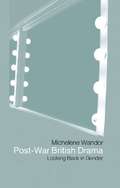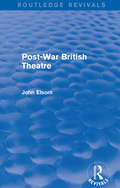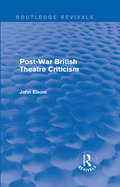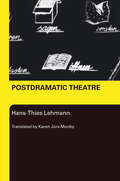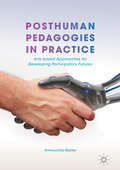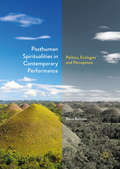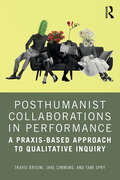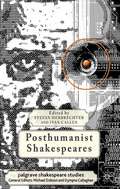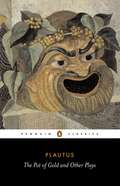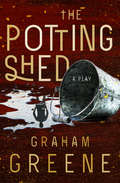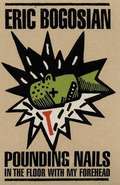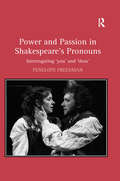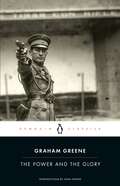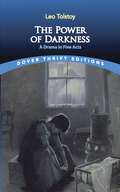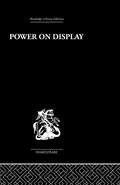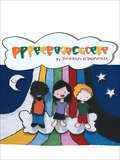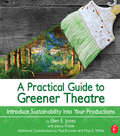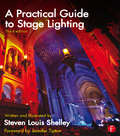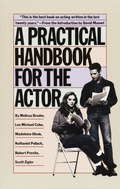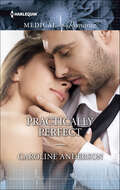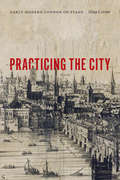- Table View
- List View
Post-Democracy
by Hannah MoscovitchThe play is based on Hannah’s experiences of being around high-level corporate executives for years as a bartender—as the daughter of socialist and left-wing thinkers, she “felt like a spy.”First produced in a digital-only production by Prairie Theatre Exchange in April 2021
The (Post) Mistress
by Tomson HighwayMarie-Louise Painchaud has worked for thirty-five years as post mistress at the post office in Lovely, a francophone Canadian village where she has come to know every client whose mail she handles. The (Post) Mistress is a rollicking, emotional rollercoaster-ride in the form of a one-woman musical, with elements of jazz, Berlin cabaret, French café music, and Brazilian samba.
Post-Show Discussions in New Play Development
by Teresa A. FisherMany theatres host post-show discussions, or talkbacks, as part of their season. This book is a critical examination of what has/has not worked with post-show discussions utilized in new play development, providing a framework for understanding discussions, steps for building the foundation of them, and various strategies for structuring them.
Post-war British Drama: Sexuality And The Family In Post-war British Drama (Routledge Revivals Ser.)
by Michelene WandorIn this extensively revised and updated edition of her classic work, Look Back in Gender, Michelene Wandor confirms the symbiotic relationship between drama and gender in a provocative look at key, representative British plays from the last fifty years. Repositioning the text at the heart of hteatre studies, Wandor surveys plays by Ayckbourn, Beckett, Churchill, Daniels, Friel, Hare, Kane, Osborne, Pinter, Ravenhill, Wertenbaker, Wesker and others. Her nuanced argument, central to any analysis of contemporary drama, discusses: *the imperative of gender in the playwright's imagination *the function of gender as a major determinant of the text's structural and narrative drives *the impact of socialism and feminism on post-war British drama, and the relevance of feminist dynamics in drama *differences in the representation of the fmaily, sexuality and the mother, before and after 1968 *the impact of the slogan that the 'personal is political' on contemporary form and content.
Post-War British Theatre (Routledge Revivals)
by John ElsomSince the Second World War, we have witnessed exciting, often confusing developments in the British theatre. This book, first published in 1976, presents an enlightening, objective history of the many facets of post-war British theatre and a fresh interpretation of theatre itself. The remarkable and profound changes which have taken place during this period range from the style and content of plays, through methods of acting, to shapes of theatres and the organisational habits of managers. Two national theatres have been brought almost simultaneously into existence; while at the other end of the financial scale, the fringe and pub theatres have kicked their way into vigorous life. The theatre in Britain has been one of the post-war success stories, to judge by its international renown and its mixture of experimental vitality and polished experience. In this book Elsom presents an approach to the problems of criticism and appreciation which range beyond those of literary analysis.
Post-War British Theatre Criticism (Routledge Revivals)
by John ElsomThis book, first published in 1981, sets out the critical reaction to some fifty key post-war productions of the British theatre, as gauged primarily through the contemporary reviews of theatre critics. The plays chosen are each, in their different ways, important in their contribution to the development of the British theatre, covering the period from immediately after the Second World War, when British theatre fell into decline, through the revival of the late 1950s, to the time in which this book was first published, in which British theatre enjoyed a high international reputation for its diversity and quality. This book is ideal for theatre studies students, as well as for the general theatre-goer.
Postdramatic Theatre
by Hans-Thies LehmannNewly adapted for the Anglophone reader, this is an excellent translation of Hans-Thies Lehmann’s groundbreaking study of the new theatre forms that have developed since the late 1960s, which has become a key reference point in international discussions of contemporary theatre. In looking at the developments since the late 1960s, Lehmann considers them in relation to dramatic theory and theatre history, as an inventive response to the emergence of new technologies, and as an historical shift from a text-based culture to a new media age of image and sound. Engaging with theoreticians of 'drama' from Aristotle and Brecht, to Barthes and Schechner, the book analyzes the work of recent experimental theatre practitioners such as Robert Wilson, Tadeusz Kantor, Heiner Müller, the Wooster Group, Needcompany and Societas Raffaello Sanzio. Illustrated by a wealth of practical examples, and with an introduction by Karen Jürs-Munby providing useful theoretical and artistic contexts for the book, Postdramatic Theatre is an historical survey expertly combined with a unique theoretical approach which guides the reader through this new theatre landscape.
Posthuman Pedagogies in Practice: Arts based Approaches for Developing Participatory Futures
by Annouchka BayleyThis book investigates transdisciplinary, arts-based approaches to developing innovative and pertinent higher education pedagogy. Introducing timely critical thinking strategies, the author addresses some of the key issues facing educators today in an increasingly complex digital, technological and ecological world. The author combines emerging ideas in the New Materialism and Posthumanism schools of thought with arts-based teaching and learning, including Practice-as-Research, for Social Science contexts, thus exploring how this approach can be used to productively create new pedagogical strategies. Drawing on a rich repertoire of real-life examples, the volume suggests transferrable routes into practice that are suitable for lecturers, researchers and students. This practical and innovative volume will appeal to researchers and practitioners interested in Posthuman and New Materialist theories, and how these can be applied to the educational landscape in future.
Posthuman Spiritualities in Contemporary Performance: Politics, Ecologies and Perceptions
by Silvia BattistaThis book provides an interpretative analysis of the notion of spirituality through the lens of contemporary performance and posthuman theories. The book examines five performance/artworks: The Artist is Present (2010) by Marina Abramović; The Deer Shelter Skyscape (2007) by James Turrell; CAT (1998) by Ansuman Biswas; Journey to the Lower World by Marcus Coates (2004); and the work with pollen by Wolfgang Laib. Through the analysis of these works the notion of spirituality is grounded in materiality and embodiment allowing the conceptual juxtaposition of spirit and matter to introduce the paradoxical as the guiding thread of the narrative of the book. Here, the human is interrogated and negotiated with/within a plurality of other living organisms, intangible existences and micro and macrocosmic ecologies. Silence, meditation, shamanic journeys, reciprocal gazing, restraint, and contemplation are analyzed as technologies used to manipulate perception and adventure into the multilayered condition of matter.
Posthumanist Collaborations in Performance: A Praxis-based Approach to Qualitative Inquiry
by Travis Brisini Jake Simmons Tami SpryPosthumanist Collaborations in Performance presents a novel approach for readers to engage with new materialist performance as a method of qualitative inquiry and as a means of combating the anthropocentric loneliness of modern life.It offers a theoretical and practical examination of how we are fundamentally entangled with a more-than-human world through practices the authors call “naturecultural performances.” The book features a collaborative body of arts-based research by three scholars working at the intersections of performance studies, new materialism, environmental studies, and qualitative inquiry. The result is an interdisciplinary body of theoretical scholarship, including a wide array of landscapes, plants, animals, minerals, and other more-than-human agencies. The book also presents practical examples and case studies of naturecultural performances, showcasing the diverse ways in which the concept of “natureculture” can be applied in research and creative practice.This book will be of interest to faculty, graduate and undergraduate students, performance practitioners, and anyone else interested in exploring or creating work based on their own fundamental relationships with the more-than-human world.
Posthumanist Shakespeares
by Stefan HerbrechterShakespeare scholars and cultural theorists critically investigate the relationship between early modern culture and contemporary political and technological changes concerning the idea of the 'human. ' The volume covers the tragedies King Lear and Hamlet in particular, but also provides posthumanist readings of other Shakespearean plays.
The Pot of Gold and Other Plays
by PlautusOne of the supreme comic writers of the Roman world, Plautus (c.254-184 BC), skilfully adapted classic Greek comic models to the manners and customs of his day. This collection features a varied selection of his finest plays, from the light-hearted comedy Pseudolus, in which the lovesick Calidorus and his slave try to liberate his lover from her pimp, to the more subversive The Prisoners, which raises serious questions about the role of slavery. Also included are The Brothers Menaechmus, which formed the prototype for Shakespeare's The Comedy of Errors, and The Pot of Gold, whose old miser Euclio is a glorious study in avarice. Throughout, Plautus breathes new, brilliant life into classic comic types - including deceitful twins, scheming slaves, bitter old men and swaggering soldiers - creating an entertaining critique of Roman life and values.
The Potting Shed: A Play
by Graham GreeneFrom the British novelist, this Tony Award–winning drama of family secrets delivers &“brilliantly effective . . . enormously provocative . . . theatrical suspense&” (New York Post). The Callifer family has assembled in the English country home of Wild Grove where its patriarch—a once-renowned rationalist and man of letters—nears death. Arriving unexpectedly to pay his respects is his son, James, a pariah among the Callifers, who finds a dark veil still drawn over his mysterious childhood. It was decades ago, when James was fourteen, that something happened to him in the garden shed, a black hole in his memories. For everyone else, it&’s an unforgettable source of unease—and for some, unforgiveable. To discover the truth, James seeks out his ostracized uncle, an alcoholic priest with nothing left to lose. What unfolds makes for &“some of the most moving, forceful and compelling theatre since Eugene O&’Neill&” (The Harvard Crimson). Graham Greene&’s Tony Award–winning work for the stage made its Broadway debut in 1957 and was hailed by the New York Times as &“an original drama that probes deep into the spirit and casts a spell.&”
Pounding Nails in the Floor with My Forehead
by Eric BogosianIn his brashest solo show, performer and playwright Eric Bogosian once again aims his searing social commentary at the contemporary urban and suburban scene. "Never miss Bogosian, because the sharp-tongued, sharp-shooting Bogosian never misses."--Clive Barnes, New York Post
Power and Passion in Shakespeare's Pronouns: Interrogating 'you' and 'thou'
by Penelope FreedmanIn revealing patterns of you/thou use in Shakespeare's plays, this study highlights striking and significant shifts from one to the other. Penelope Freedman demonstrates that understanding of the implications of you/thou use in early modern English has been bedevilled by overconcern with issues of power and status, and her careful research, analysing all the plays, reveals how a fuller understanding of Shakespeare's usage can provide a key to unlock puzzles of motive and character, and a glass to clarify relationships and emotions. The work focuses particularly on dialogue between men and women, and sheds new light on male and female language use. The scholarship presented in this volume is augmented with tables and a glossary of linguistic terms.
The Power and the Glory
by John Updike Graham GreeneSeventy-five years ago, Graham Greene published The Power and the Glory, a moralist thriller that traces a line of influence back to Dostoyevsky and forward to Cormac McCarthy. Named one of the 100 best novels of the twentieth century by Time magazine, it stands today as his masterpiece. <p><p>Mexico, the late 1930s: A paramilitary group has outlawed the Catholic Church and is executing its clergy. Now the last priest is on the run, fleeing not just an unshakable police lieutenant but also his own wavering morals. As he scraps his way toward salvation, haunted by an affair from his past, the nameless “whiskey priest” is pulled between the bottle and the Bible, tempted to renounce his religion yet unable to ignore the higher calling he’s chosen. Timeless and unforgettable, The Power and the Glory is a stunning portrait of both physical and spiritual survival by a master dramatist of the human soul.
The Power of Darkness: A Drama in Five Acts (Dover Thrift Editions)
by Leo TolstoyBest known today as the author of War and Peace and Anna Karenina, Count Leo Tolstoy also is acknowledged as a skilled playwright. His five-act drama The Power of Darkness offers a cold and unsparing look at Russian peasant life that illustrates the costs of pursuing personal desires rather than the dictates of morality. The grimly realistic tragedy is based on a real incident, centering on a peasant's confession to a party of wedding guests of his participation in a series of horrific crimes that range from adultery and murder to infanticide. Tolstoy's moving portrait of a class enslaved by poverty and ignorance was written in 1886, but its performance was suppressed by Russian authorities until 1902. A 1904 version, performed in New York in Yiddish, marked the first successful production of a play by Tolstoy in the United States.
Power on Display: The Politics of Shakespeare's Genres
by Leonard TennenhouseFirst published in 1986. 'Impressively open to the complexity of cultural discourses, to the ways in which one discursive form may function as a screen for another above all to the political entailment of genre.' Stephen Greenblatt.What is the relation between literary and political power? How do the symbolic dimensions of social practice and the social dimensions of artistic practice relate to one another? Power on Display considers Shakespeare's progression from romantic comedies and history plays to tragedy and romance in the light of the general process of cultural change in the period.
pppeeeaaaccceee
by Darren O'Donnellpppeeeaaaccceee, is a vast, imaginative and mesmerizing glide through Life and Power. The play is set in Ephemeral; three people firmly floating chat - in O'Donnell's inimitable rapid-fire style - about the revolution. Which revolution? Good question. A gently aggressive meditation, pppeeeaaaccceee examines our being, asks us what we're doing and reminds us that there are monsters in here. Peace. Say it slow, stretch it out, make it last forever.
A Practical Guide to Greener Theatre: Introduce Sustainability Into Your Productions
by Ellen E. JonesProtecting the environment should be a priority of every theatrical production, but it can be challenging to mount an environmentally-friendly show with limited time, resources, and information. A Practical Guide to Greener Theatre: Introduce Sustainability Into Your Productions not only gives you the information you need to make greener decisions, but provides you with practical, workable solutions. You will learn how to assess and improve every production area – from costuming and painting, lighting and technical direction, to administrative offices and the rehearsal process. Checklists, examples of successful strategies, and step-by-step instructions will show you how to identify areas where manageable, sustainable changes can make your productions greener, and advice from working professionals, with experience greening their own productions, will leave you confident that your processes are environmentally sound. Even non-technical people who find themselves responsible for supervising productions will find green solutions that can be instituted with a staff of volunteers or students. Remember: every step toward sustainability is a step forward. Discover small fixes that will make your theatre productions greener. Examine ways to introduce greener practices in the design, execution, and strike process. Explore how introducing sustainability into your theatre productions can save your company time and money. Learn how sustainability and safety intersect to help protect your workers and volunteers.
A Practical Guide to Stage Lighting
by Steven Louis ShelleyIn the first edition of A Practical Guide to Stage Lighting, Steve Shelley cracked open his production book and showed how to prepare a lighting design and create the paperwork needed to mount a production.In the second edition, he pulled back the curtain and showed the methods and processes that go on before the light plot is finalized and ready to go to into the shop, even dealing with cutting the plot in half.In this third edition, Shelley throws the door wide open and shows step-by-step how to construct every lighting system in the Hokey light plot. Combining his diacritical analysis, killer drafting, and analytic use of the Slinky Method and Slinky Calculations, he presents the Periodic Table of Fundamental Lighting Systems and shows the basic methods used to create multi-instrument lighting systems. Highlights include:-Over 100 new topics, including analysis and application of the three categories of collaboration; a detailed examination of production meetings and one-on-one meetings; and meeting checklists with management and the creative team.-Over 50 new illustrations, including Shelley's Periodic Table of Fundamental Lighting Systems; groundplans, sections, and front elevations that illustrate basic system wash configurations for each direction of light. -Analysis, calculation, and step-by-step technical construction of each lighting system in the Hokey light plot.-Explanation of a manufacturer's cut sheet, and how to apply basic formulas to determine the beam size, footcandles, and gel transmission for lighting instruments.-Updated process of pre-programming computer lighting consoles prior to the load-in.-Comprehensive overview of archiving paperwork and softcopy for a production.
A Practical Handbook for the Actor
by Melissa Bruder6 working actors describe their methods and philosophies of the theater. All have worked with playwright David Mamet at the Goodman Theater in Chicago.From the Trade Paperback edition.
Practically Perfect
by Caroline AndersonWhen surgeon Connie Wright broke her arm, she had some serious decisions to make. It seemed natural to go home, but finding Patrick Durrant pinch–hitting for her father in his general practice was disturbing. Connie thought him deeply attractive, and his small son, Edward, soon found a place in her heart. But how could she let herself fall in love when Patrick would be moving on to a permanent country practice, and Connie would of course be returning to London?
Practicing the City: Early Modern London on Stage
by Nina LevineIn late-sixteenth-century London, the commercial theaters undertook a novel experiment, fueling a fashion for plays that trafficked in the contemporary urban scene. But beyond the stage’s representing the everyday activities of the expanding metropolis, its unprecedented urban turn introduced a new dimension into theatrical experience, opening up a reflexive space within which an increasingly diverse population might begin to “practice” the city. In this, the London stage began to operate as a medium as well as a model for urban understanding.Practicing the City traces a range of local engagements, onstage and off, in which the city’s population came to practice new forms of urban sociability and belonging. With this practice, Levine suggests, city residents became more self-conscious about their place within the expanding metropolis and, in the process, began to experiment in new forms of collective association. Reading an array of materials, from Shakespeare and Middleton to plague bills and French-language manuals, Levine explores urban practices that push against the exclusions of civic tradition and look instead to the more fluid relations playing out in the disruptive encounters of urban plurality.
